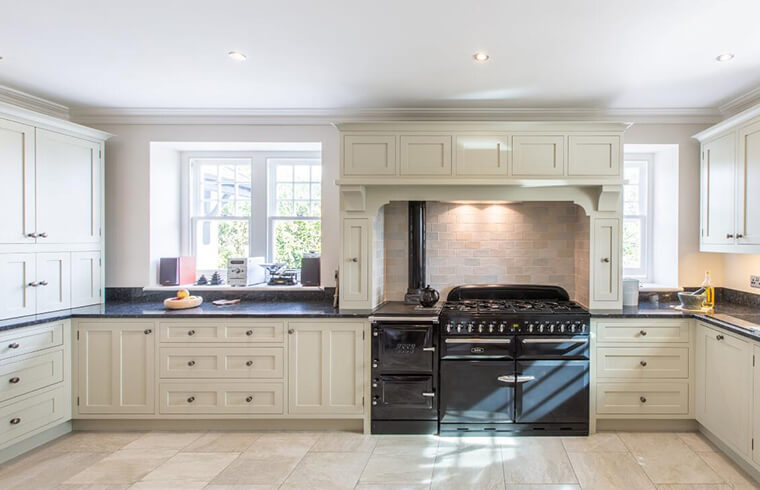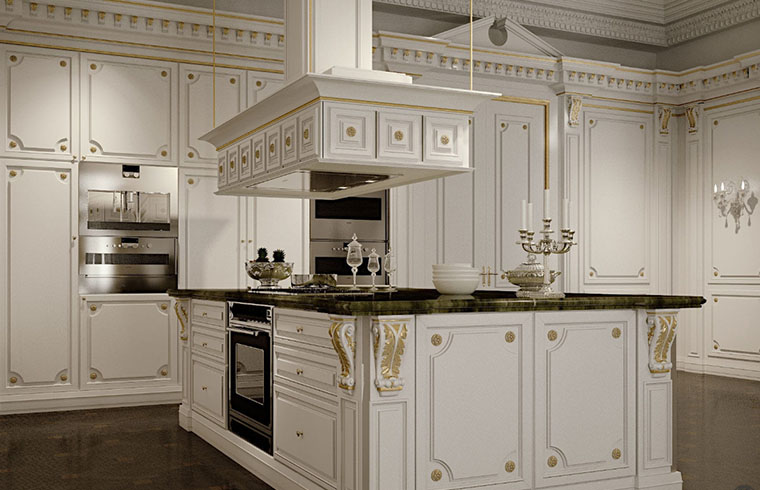When planning a kitchen renovation, the cabinet doors you choose can make or break the overall aesthetic. Among the countless options available, Shaker and Raised Panel cabinet doors stand out as timeless choices. But how do you decide which one is right for your kitchen? This guide will explore their key differences and help you make an informed decision.
Shaker cabinet doors are a timeless and versatile design characterized by their simple, clean lines and functional aesthetic. They consist of a five-piece construction: a flat central panel surrounded by four rectangular frames. This straightforward style is inspired by the Shaker religious community of the 18th century, whose principles of simplicity, utility, and craftsmanship heavily influenced the design. The cabinets lack ornate carvings or intricate detailing, which contributes to their minimalist appeal, making them a favorite in modern, Scandinavian, and coastal kitchen designs.
Traditionally, shaker doors are made from high-quality hardwoods such as maple, oak, or pine, with finishes that enhance the wood’s natural beauty, like light stains or clear varnishes. For contemporary preferences, they are also available in painted finishes, with white, gray, and navy being popular choices. Shaker doors seamlessly blend form and function, offering durability and easy maintenance.
Their understated design ensures they complement various interiors, whether paired with modern stainless-steel hardware for a sleek look or with rustic brass pulls for a farmhouse vibe. This adaptability, combined with their timeless elegance, has cemented their place as one of the most enduring cabinet styles in both traditional and contemporary homes.

Raised panel cabinet doors are a classic and sophisticated style that adds depth and dimension to any kitchen or bathroom. These doors feature a central panel that is slightly elevated, or "raised," compared to the surrounding frame. The raised panel typically slopes backward, creating a three-dimensional effect that brings texture and visual interest to the design. Raised panel cabinets are often crafted with intricate details, such as beveled edges, decorative grooves, or even carvings, adding an extra layer of sophistication.
This style is rooted in traditional cabinetmaking, dating back to the 17th century, and became particularly popular in colonial America. Raised panel cabinet doors are typically made from solid wood, like cherry, oak, or maple, and are often finished with rich stains or glazes to highlight the natural grain of the wood. The frame surrounding the panel may also be elaborately designed, with options for arches, beading, or stepped profiles that further enhance the overall appearance.
Raised panel cabinets are commonly found in classic or traditional-style kitchens, especially in farmhouse, Mediterranean, and colonial-inspired designs. Their detailed craftsmanship and elegant appearance make them a great choice for homeowners seeking a timeless, high-end look. These doors are a perfect balance between form and function, offering both aesthetic appeal and durability for long-lasting use.
When choosing between shaker and raised panel cabinet doors, understanding their key differences can help you make the right decision based on your kitchen's style, budget, and maintenance needs.
1. Aesthetic Appeal:
Shaker cabinet doors are known for their minimalist and modern design. The clean lines and simple structure of these doors create an understated look that is both stylish and functional. Shaker doors are perfect for those who want a sleek and contemporary aesthetic, blending seamlessly into modern, transitional, or even Scandinavian-inspired kitchens.
Raised panel doors offer a more formal, ornate style that adds sophistication and depth to a room. The raised central panel, along with intricate detailing such as beveled edges, carvings, and decorative overlays, provides a luxurious appearance that fits well in traditional and classic kitchens, particularly in Mediterranean, colonial, or farmhouse designs. The ornate features of raised panel doors make them an ideal choice for homeowners seeking a more elaborate and high-end look.
2. Construction Style:
Shaker cabinet doors often feature a frameless construction, which contributes to their clean and streamlined appearance. This frameless design eliminates unnecessary embellishments, allowing the natural beauty of the wood to take center stage. It gives the cabinet a more modern feel, aligning with the simplicity and functionality that Shaker-style furniture is known for.
In contrast, raised panel doors typically utilize a framed construction. The frame surrounding the raised central panel emphasizes the cabinet's traditional design, giving it a more dimensional, structured look. The framed construction is essential to the ornate style of raised panel doors, reinforcing their classic appeal and creating a sense of depth and intricacy.
3. Cost:
When comparing the costs of these two styles, Shaker doors tend to be more budget-friendly. The simplicity of their design and the use of straightforward construction methods make them less expensive to produce, which is reflected in their price.
Raised panel doors, however, can be more costly due to the intricate craftsmanship and the detailed design elements involved in their production. The added complexity of carving, framing, and additional decorative touches increases both material and labor costs, resulting in a higher price tag. While raised panel doors may be pricier, their timeless elegance may justify the additional investment for those seeking a more traditional or luxurious aesthetic.
4. Maintenance:
Both shaker and raised panel doors require regular upkeep to maintain their appearance. Shaker doors are generally easier to clean, as their simple design features fewer grooves and intricate details where dust and grime can accumulate. The smooth, recessed edges of Shaker doors can be wiped down with minimal effort.
Raised panel doors, however, may require more attention when cleaning. The grooves, carvings, and edges of raised panel doors can trap dust and dirt, making them more time-consuming to maintain. While both styles can last a long time with proper care, Shaker doors may be a more practical option for those who prefer low-maintenance cabinetry.
5. Design Compatibility:
In terms of design, Shaker doors are versatile and fit well in contemporary, minimalist, and transitional spaces. Their timeless appeal allows them to adapt to a wide range of aesthetics, from modern urban kitchens to cozy coastal retreats.
Raised panel doors, on the other hand, complement more traditional or classic kitchen styles. They are particularly suited for homeowners looking to evoke a sense of nostalgia or history in their design, making them perfect for Mediterranean, farmhouse, or colonial-inspired interiors. When choosing between these two options, consider the overall theme of your space and which style aligns best with your vision for the room.

Choosing the right style of cabinet doors for your kitchen is an important decision that impacts both the look and functionality of the space. When deciding between Shaker and raised panel doors, several factors should be taken into account to ensure the doors complement your kitchen’s design and meet your specific needs.
The first thing to consider is the overall theme or style of your kitchen. Shaker doors are a perfect fit for modern, minimalist, or transitional kitchens, where the focus is on clean lines, simplicity, and functionality. Their subtle design works seamlessly in spaces where less is more. On the other hand, raised panel doors bring a sense of richness and sophistication that suits more traditional, formal kitchens. If your kitchen features classic or vintage elements, or if you prefer a more ornate and timeless look, raised panels may be the ideal choice. The decorative detailing of raised panels adds depth and character, making them perfect for creating a high-end, luxurious atmosphere.
Your budget plays a key role in determining which style is best for you. Shaker doors are generally more affordable because of their simpler construction and streamlined design. The minimal materials required and the efficient production process make them a cost-effective choice for those working with a tighter budget. Raised panel doors, with their more intricate design and craftsmanship, tend to be more expensive. The added cost comes from the detailed woodwork, framing, and raised elements, which require more time and skill to create. If cost is a major concern, Shaker doors offer an excellent balance between quality and affordability.
Consider how much time and effort you’re willing to spend on maintenance. Shaker doors are easier to clean and maintain due to their simple design. Without intricate grooves or carvings, there are fewer places for dust and debris to accumulate. This makes Shaker doors a low-maintenance option, ideal for busy households or those who prefer simplicity in upkeep. Raised panel doors, with their decorative details, may require more attention to keep them looking their best. The grooves and intricate carvings can trap dirt, making cleaning a bit more time-consuming. If ease of maintenance is a priority, Shaker doors are the more practical choice.
Ultimately, your personal style and taste should guide your decision. Do you prefer a clean, minimalist aesthetic, or are you drawn to the elegance and detail of traditional designs? Shaker doors are perfect for those who favor simplicity and a contemporary feel, while raised panel doors appeal to those who enjoy decorative flourishes and classic beauty. Think about what suits your vision for the space and the atmosphere you wish to create in your kitchen.
In conclusion, selecting the right cabinet door style depends on the balance of your kitchen’s theme, budget, maintenance needs, and personal aesthetic preferences. By considering these factors carefully, you can choose the doors that best enhance your kitchen's design and functionality.
If you’d like some help in picking out wood cabinets that suit your style or fit your kitchen, BFP designers are here to help!
We employ cookies to analyze website traffic and enhance your browsing experience. Data securely aggregated, privacy protected. See Privacy Policy for details.